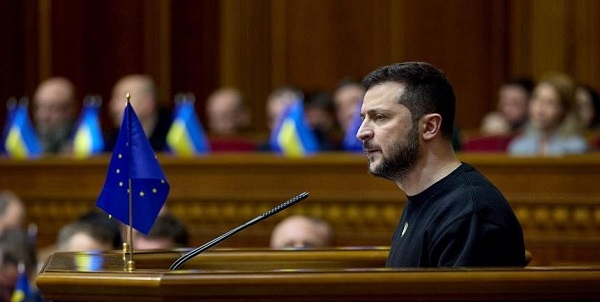Zelenskiy’s 10-Point Peace Plan- Highlights, Response & India’s Options

From Current Affairs Notes for UPSC » Editorials & In-depths » This topic
IAS EXPRESS Vs UPSC Prelims 2024: 85+ questions reflected
Volodymyr Zelenskiy, Ukraine’s President, has been promoting a 10-point peace plan, in a quest to bring some semblance of political stability in eastern Europe, amid the ongoing Russia-Ukraine War. He has also been calling for a Global Peace Summit based on this plan.

What are the highlights?
The Ukrainian President announced the 10-point plan at a G20 Summit in November this year. Over the weeks, he has been discussing the idea with multiple heads of state, including the US President. The key highlights of the plan are:
- Radiation and nuclear safety: with a focus on restoring the Zaporizhzhia power plant (Europe’s largest nuclear power plant) that is currently in a Russian-occupied region.
- Food security: focusing on enabling and protecting Ukraine’s grain exports to poorer countries.
- Energy security: focusing on price caps on Russian energy resources and aiding Ukraine in restoring power infrastructure, especially given how half of it has been damaged by the ongoing conflict.
- Prisoners’ and deportees’ release: including release of prisoners of war and children deported to Russia.
- Restoration of Ukrainian territorial integrity and its reaffirmation from Russia according to the UN Charter (non negotiable).
- Russian troops’ withdrawal, cessation of hostilities and restoration of Russia-Ukraine border.
- Justice: establishment of a special tribunal for prosecuting Russian war crimes.
- Ecocide, environmental protection focusing on demining and restoring water treatment infrastructure.
- Preventing conflict escalation and developing security architecture, including guarantees for Ukraine, in the Euro-Atlantic space.
- Confirmation of the end of the war and conclusion of a document by the parties involved.
How is the world responding?
- Russia has outright rejected the proposal. Moscow said that it wouldn’t be giving up any Ukrainian territory (some 1/5th of Ukraine’s territory has been annexed).
- The West, headed by Washington, for its part has been contributing to Ukrainian military for months, with the aid running into billions of dollars. For instance, the countries have been significantly involved in demining and fixing Kyiv’s power infrastructure.
- For instance, recently, the US administration announced a$1.84 aid to Ukraine’ war efforts. This includes a Patriot missile battery system.
- However, the West’s response to the peace plan and the proposed peace summit has been on the cautious side. For instance:
- US President said he shared Zelenskiy’s ‘exact same vision’ for peace and that the USA is committed to ensuring Ukraine’s self-defence.
- The G7 leaders said that they are committed to enabling peace in Ukraine ‘in line with the rights enshrined in the UN Charter’.
- Apart from this, Zelenskiy has also been reaching out to other leaders, such as the French President and the Indian Prime Minister.
- India gave a cautiously worded response, reiterating its call for an ‘immediate cessation of hostilities’ and calling on both sides to ‘revert to dialogue and diplomacy’. India conveyed its support for any peace process.
What can India do?
- The recent appeal by Ukraine to India is based on the understanding that New Delhi is willing to be involved in the peace process, especially given the Indian statement to Russia, in September, that this ‘is not the era for war’.
- India taking up the G20 presidency has provided an immediate context for the Ukrainian President to contact the Indian PM with his 10-point peace plan. India’s support would help Ukraine bring up the formula formally at the G20 summit.
- India’s statement is being perceived as an expression of frustration with Russia for putting it in a difficult position. Notably, the annual India-Russia Summit, the most significant event in the India-Russia engagement calendar, is yet to take place.
- While both Ukraine and Russia are seeking to be perceived as taking efforts to bring the war to a close through talks, the war has been going on for more than 10 months now and doesn’t seem to be ending anytime soon.
- Russia is claiming that Ukraine’s Western allies are impeding its talks with the Eastern European country and Ukraine is claiming that the Russian President is attempting to divert attention from his real intention i.e. to seize more territory.
- However, India’s wariness in dealing with both the countries is understandable given the uncertainties in the conflict and its serious economic fallout. Even the UN Secretary General took note of the small chances for any solid peace talks at the moment.
- Adding to this, New Delhi has its own problems to worry about, such as the conflicts on its own borders.
- India is expected to contribute to the peace process when both the sides are genuinely ready to come to the table for talks and then, multilateral efforts would yield a positive outcome.
Conclusion:
The Russia-Ukraine War has been a major blemish of 2022- not only in European, but in the larger global politics. While the 10-point peace plan seeks to address many pressing issues and India has a great opportunity to establish its role as a responsible neutral player in international relations, there is only so much that can be done until both countries are ready to hold genuine talks.
Practice Question for Mains:
What is the 10 point peace plan put forth by Ukraine? How can India contribute to the peace process? (250 words)
If you like this post, please share your feedback in the comments section below so that we will upload more posts like this.

